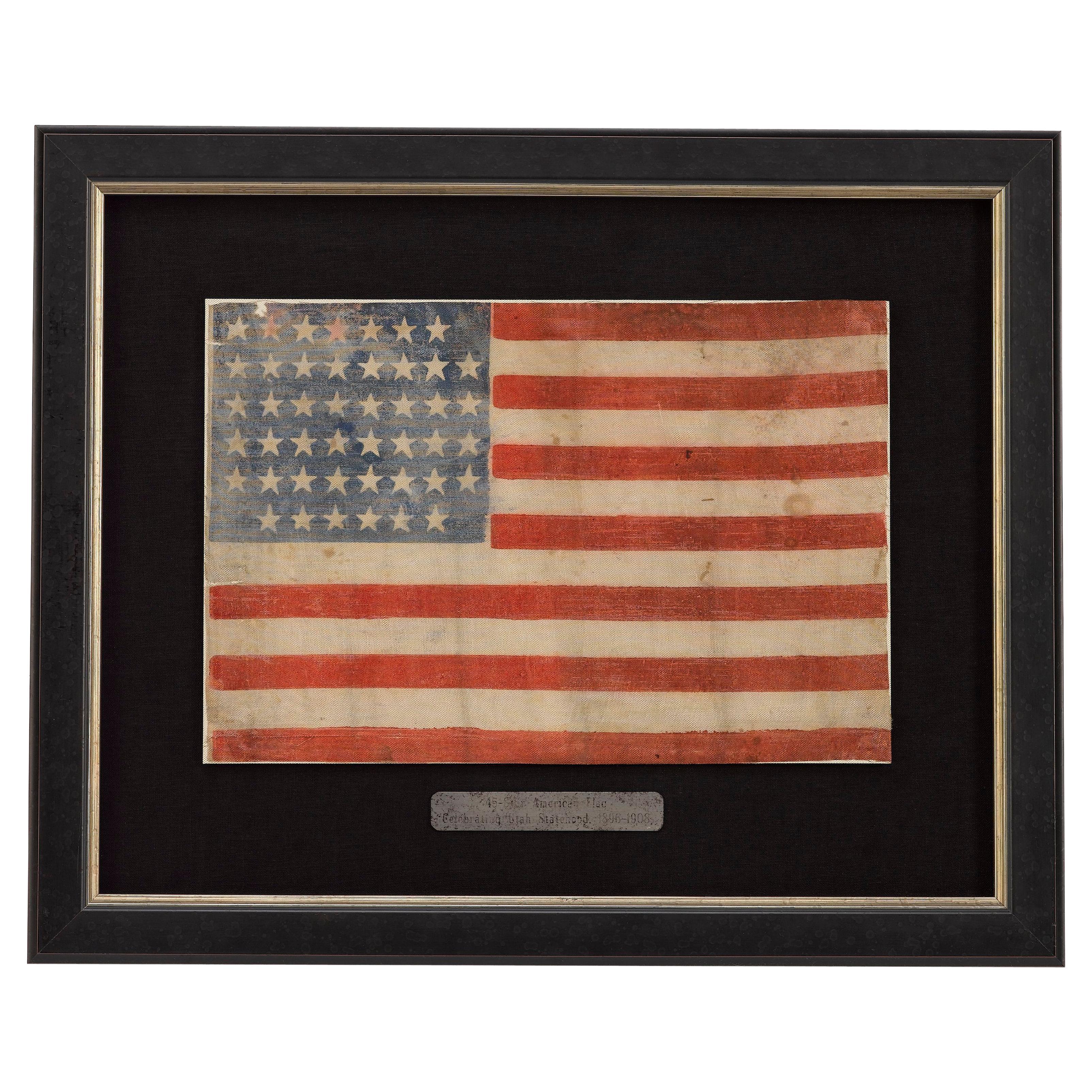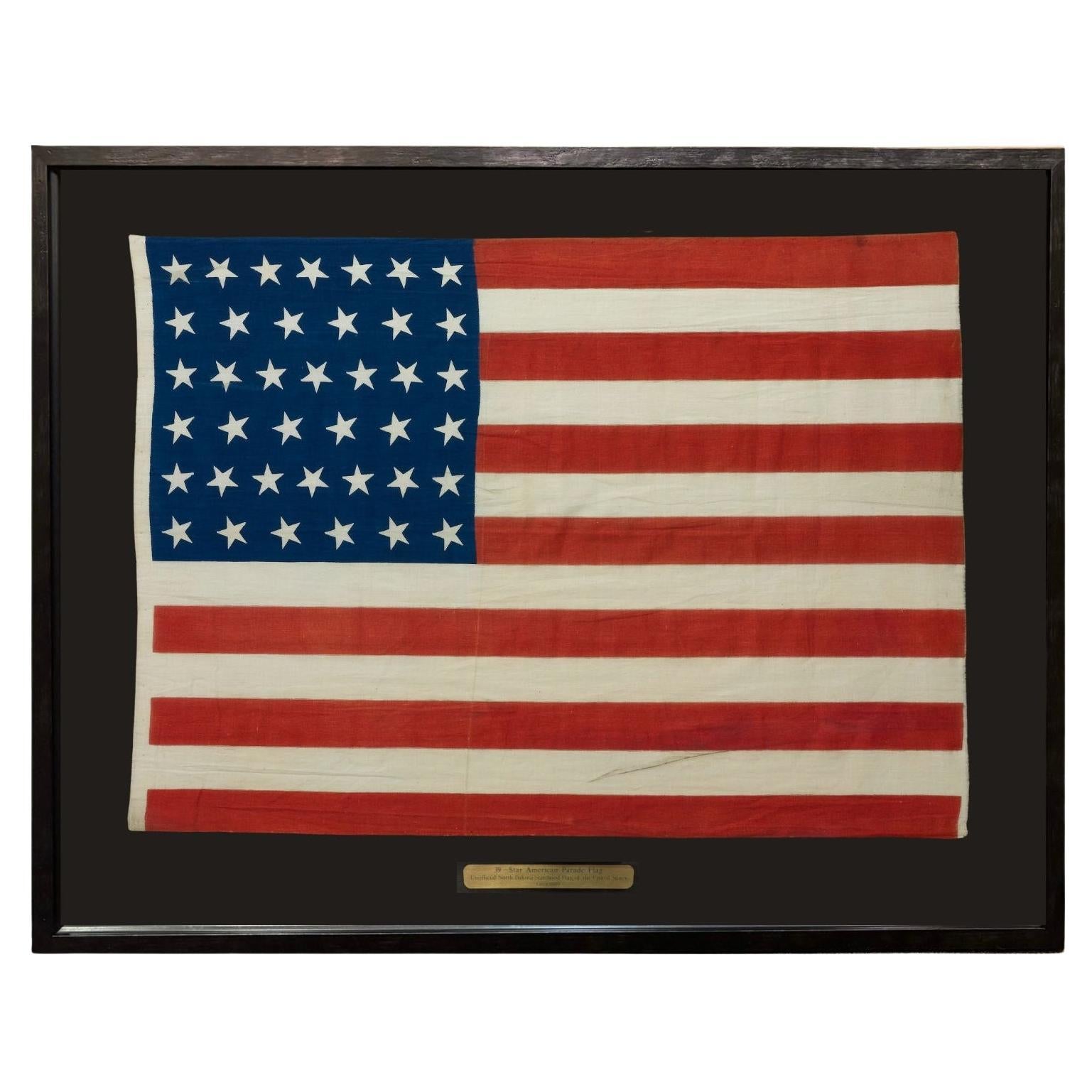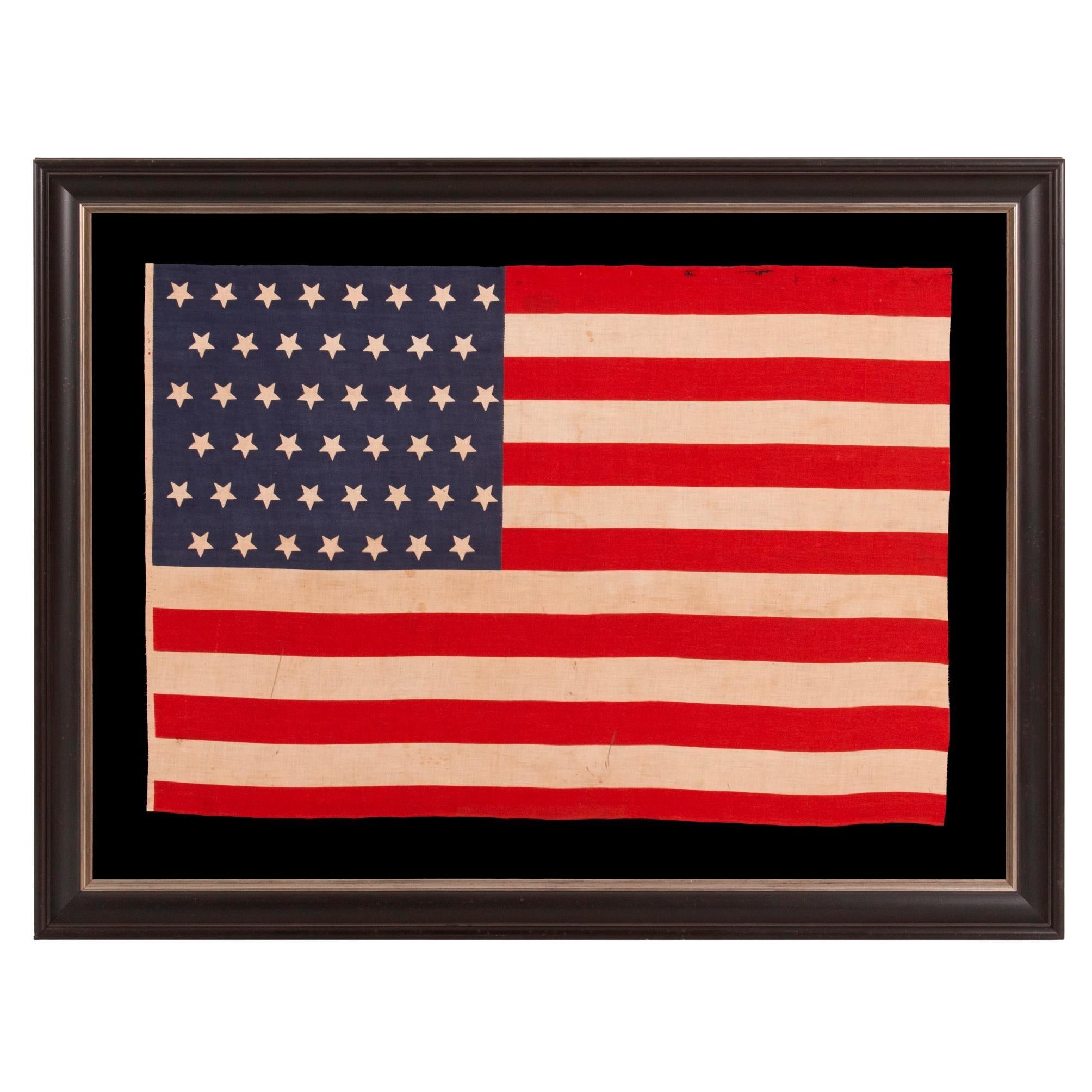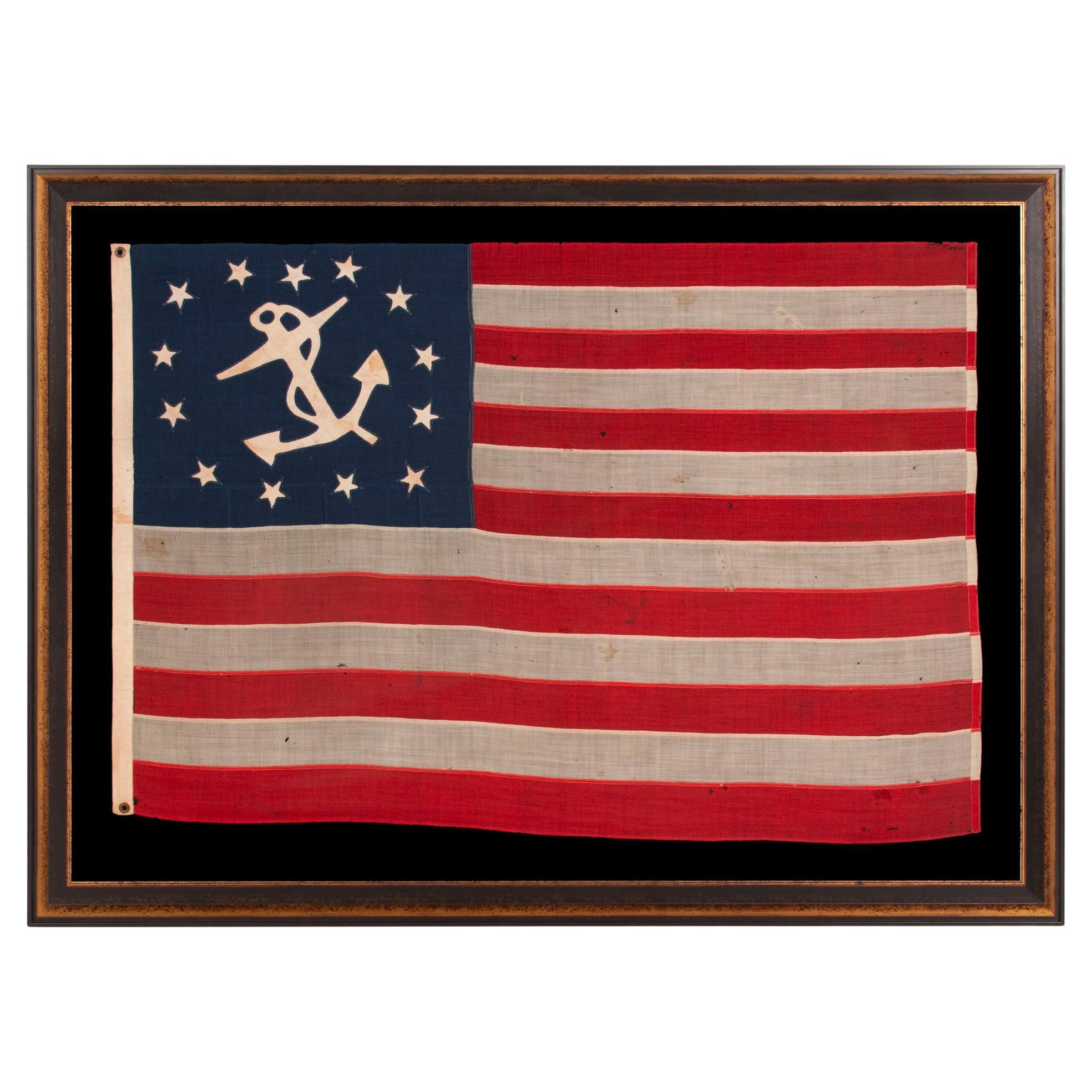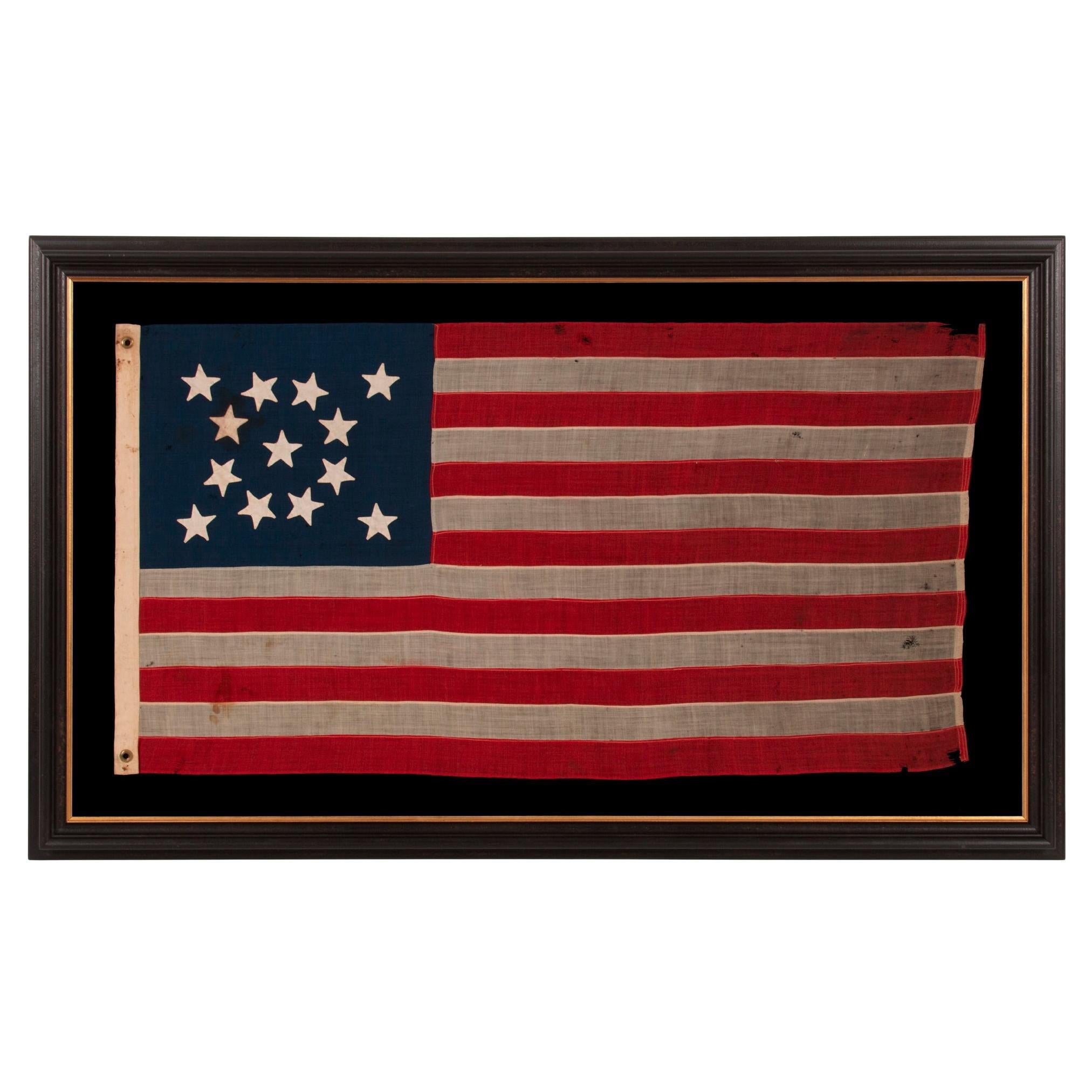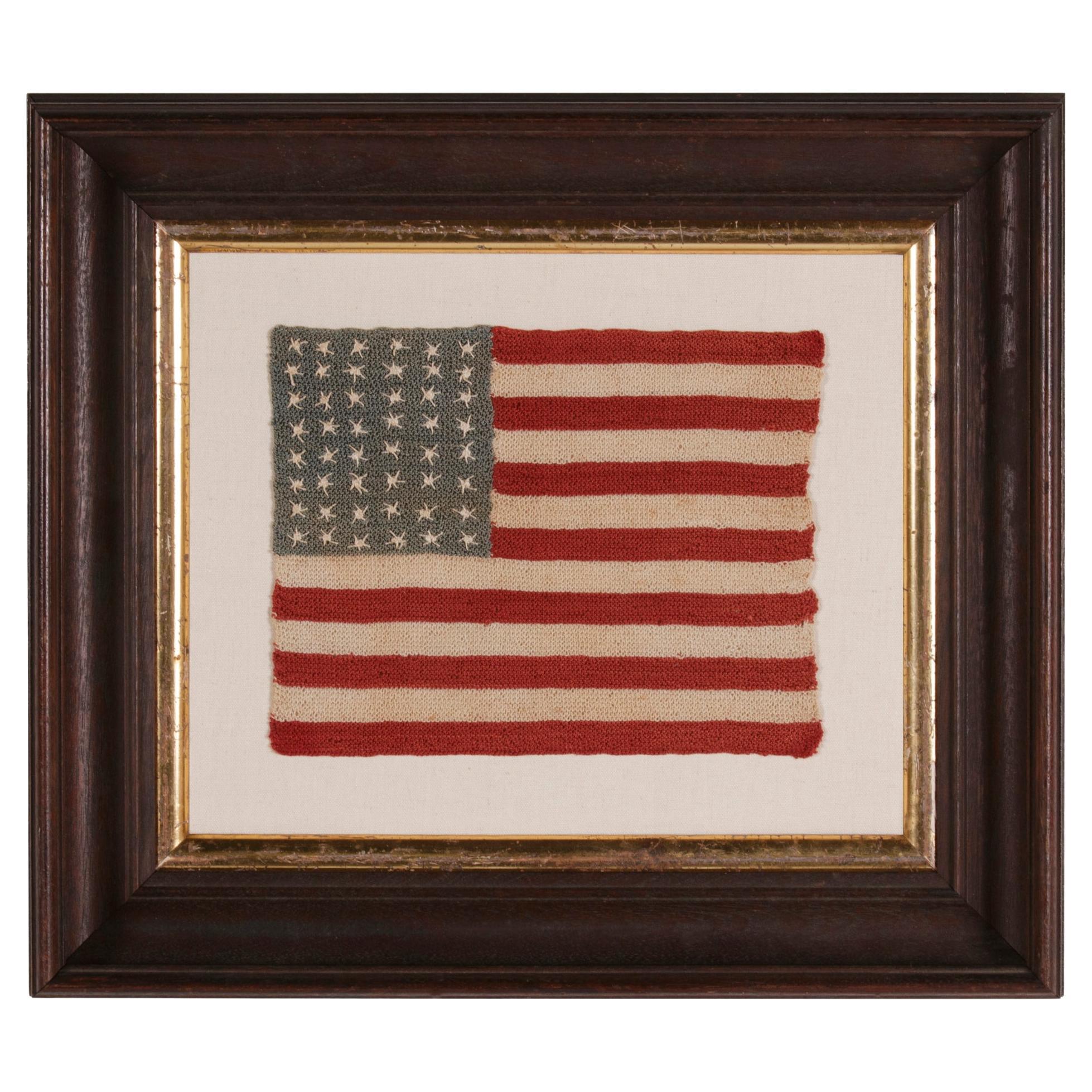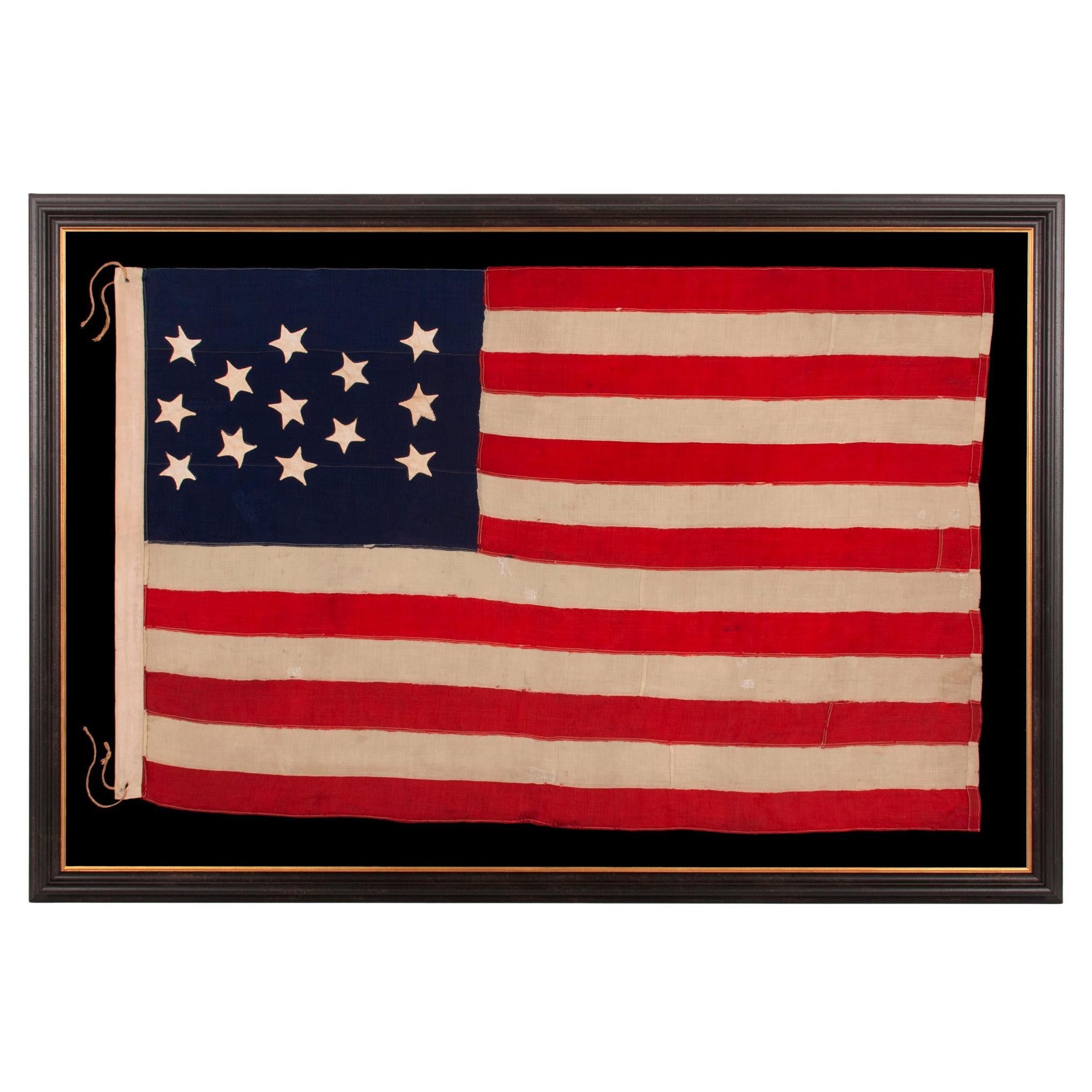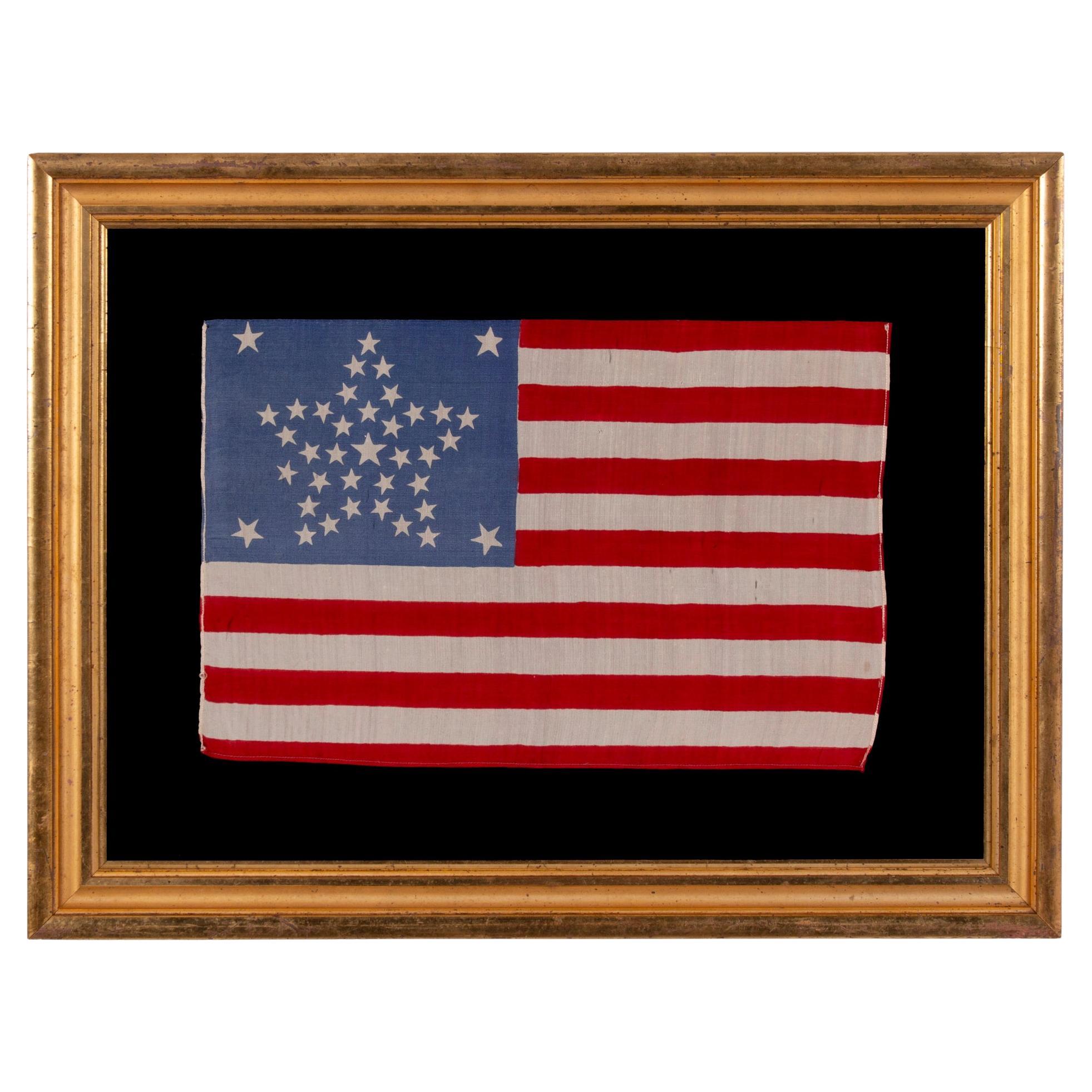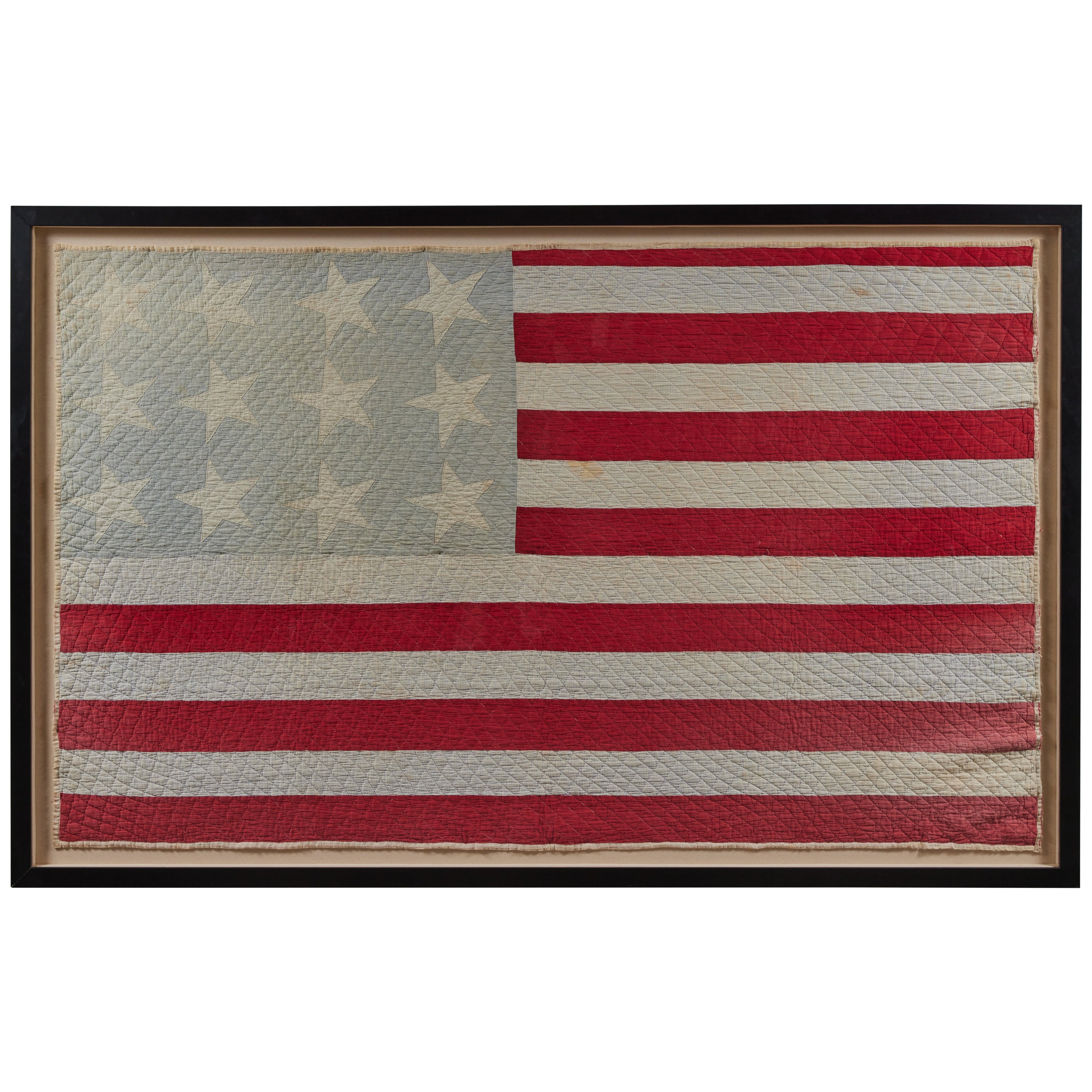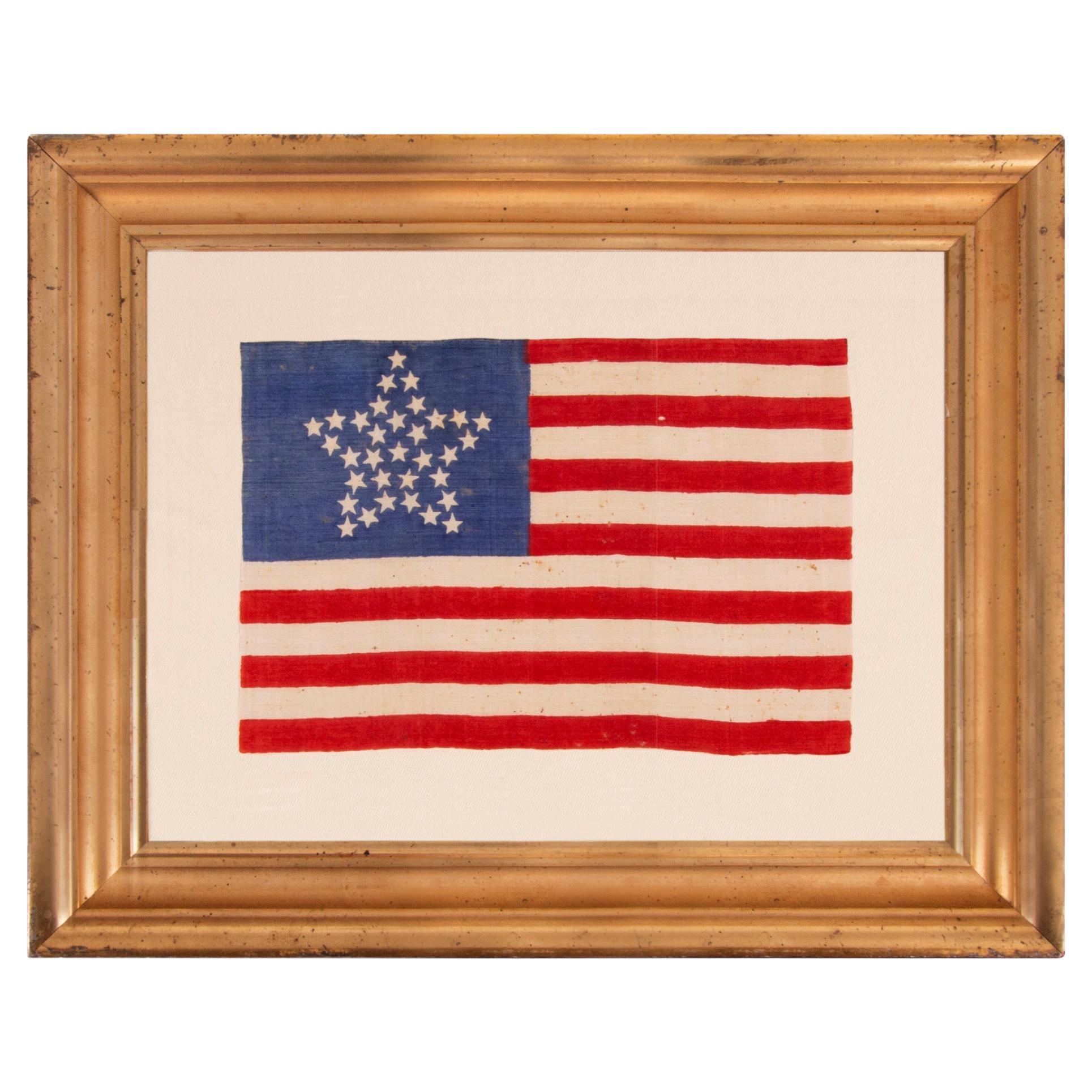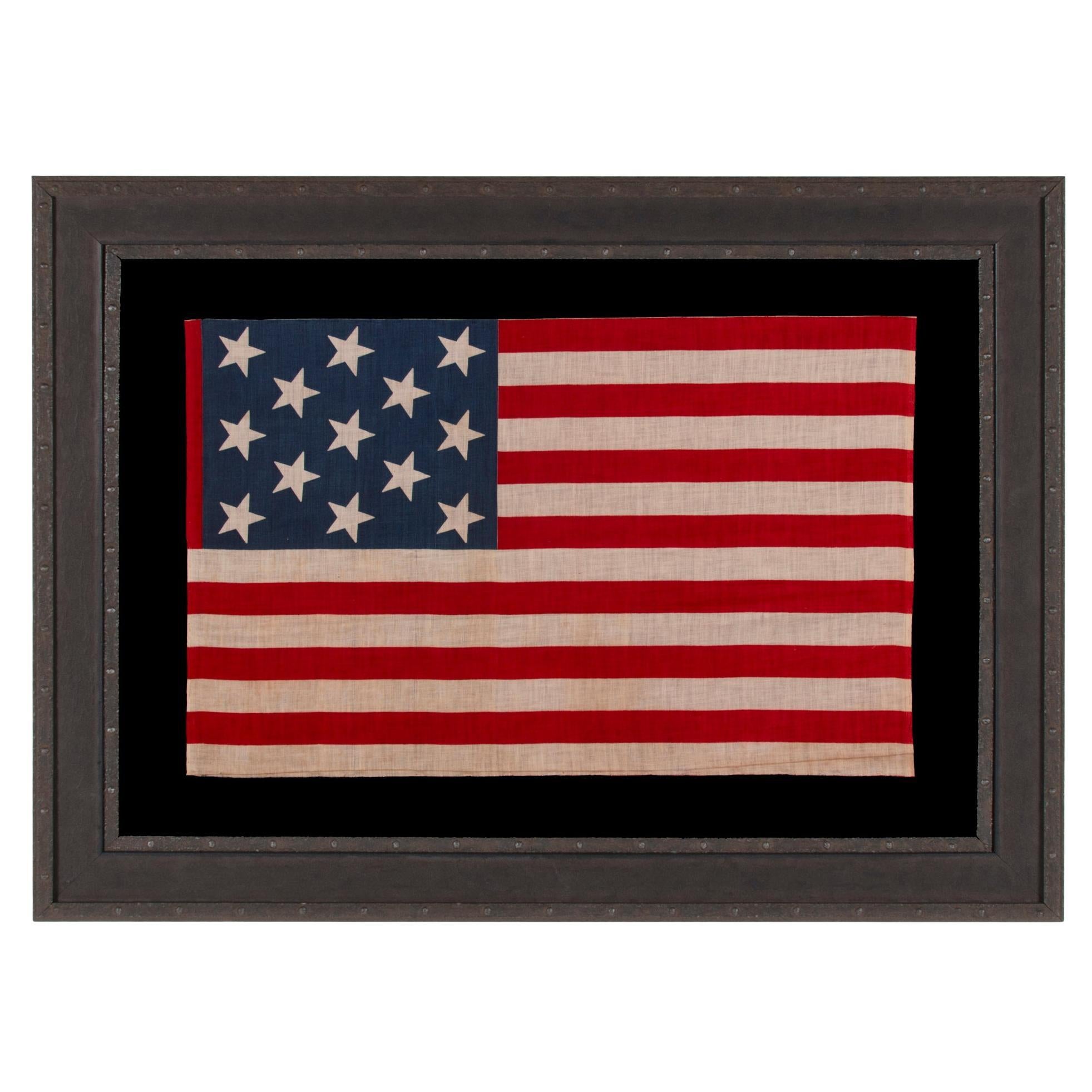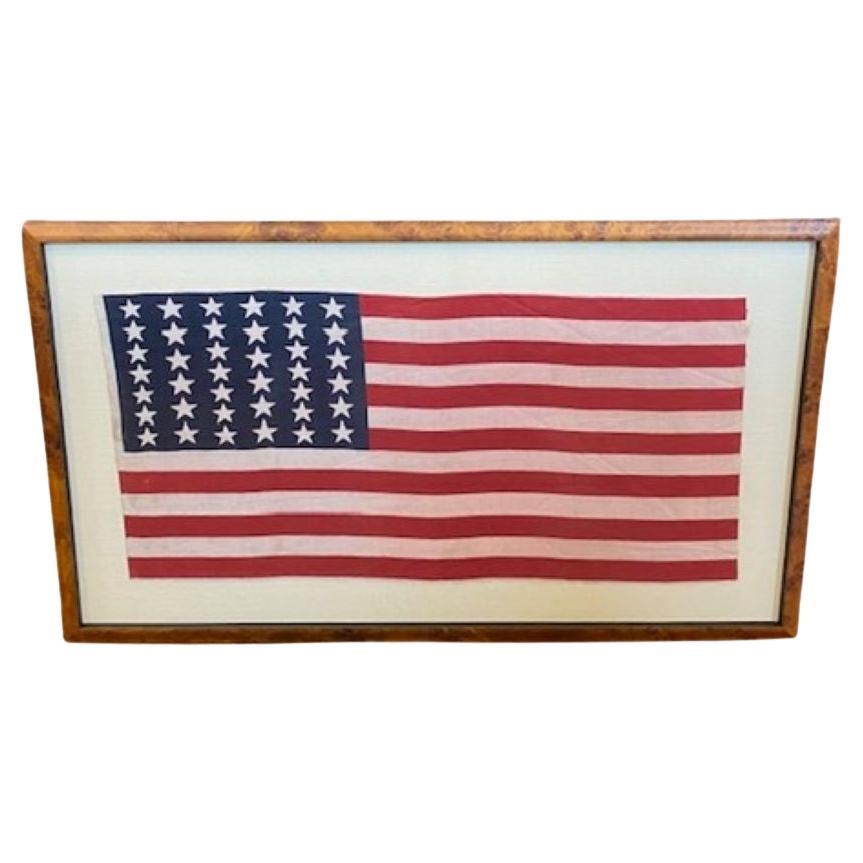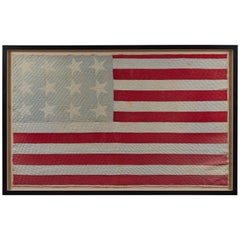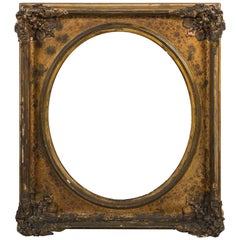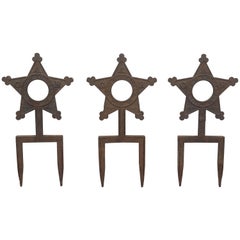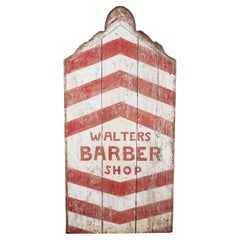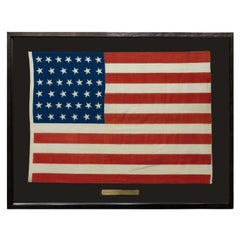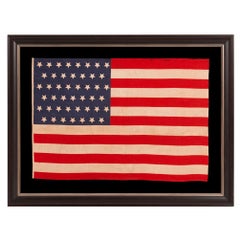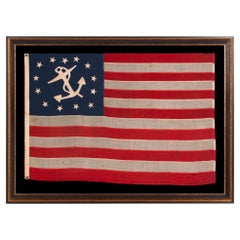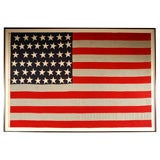
Giant Framed 45 Star Hand Stitched And Signed American Flag
View Similar Items
Want more images or videos?
Request additional images or videos from the seller
1 of 8
Giant Framed 45 Star Hand Stitched And Signed American Flag
$4,500List Price
About the Item
- Dimensions:Height: 80 in (203.2 cm)Width: 119 in (302.26 cm)Depth: 2 in (5.08 cm)
- Materials and Techniques:
- Place of Origin:
- Period:
- Date of Manufacture:1898
- Condition:Please note that the dark upper portions in the images are a result of the camera flash. The flag is evenly colored. The flag appears to have been gently used and is in good condition. Some small holes and one small make-do repair.
- Seller Location:Santa Monica, CA
- Reference Number:1stDibs: 090707873412
About the Seller
4.9
Vetted Professional Seller
Every seller passes strict standards for authenticity and reliability
1stDibs seller since 2009
251 sales on 1stDibs
Authenticity Guarantee
In the unlikely event there’s an issue with an item’s authenticity, contact us within 1 year for a full refund. DetailsMoney-Back Guarantee
If your item is not as described, is damaged in transit, or does not arrive, contact us within 7 days for a full refund. Details24-Hour Cancellation
You have a 24-hour grace period in which to reconsider your purchase, with no questions asked.Vetted Professional Sellers
Our world-class sellers must adhere to strict standards for service and quality, maintaining the integrity of our listings.Price-Match Guarantee
If you find that a seller listed the same item for a lower price elsewhere, we’ll match it.Trusted Global Delivery
Our best-in-class carrier network provides specialized shipping options worldwide, including custom delivery.More From This Seller
View AllLarge Framed American Flag Folk Art Quilt
Located in Santa Monica, CA
Nicely faded American flag quilt. Excellent hand stitched dancing Folk Art stars. Skilled quilting, a nice graphic large-scale wall hanging. White ...
Category
Early 20th Century North American Folk Art Political and Patriotic Memor...
Materials
Cotton
19th Century Gilt and Gesso Frame attributed to President James Polk Estate
Located in Santa Monica, CA
Early 19th century gilt and gesso picture frame. Found at an estate sale in Columbia, Tennessee. Objects from the sale were attributed to President James K. Polk's estate. Fantastic ...
Category
Antique 19th Century American Folk Art Picture Frames
Materials
Gesso, Wood
Collection of Three Cast Iron Star Victorian Daughters of the Revolution Markers
Located in Santa Monica, CA
Collection of three Daughters of the Revolution cast iron star markers. Marked GAR Thos Feushaw Post 75 Conn.
Category
Antique 1890s North American Folk Art Garden Ornaments
Materials
Iron
Giant Wood Early 20th Century Hand Painted Americana Barber Shop Sign
Located in Santa Monica, CA
Large and chunky Americana! Fantastic and original Barber Shop trade sign in the shape of a barber pole. Great statement piece. Layers of super graphic red and white original paint. ...
Category
Early 20th Century American Folk Art Signs
Materials
Wood
American Folk Art Wood and Iron Farm Bureau Weathervane Advertising Sign
Located in Santa Monica, CA
Great looking cartoon Midwestern Americana weathervane. Farm Bureau Insurance started in 1921. This great piece most likely was a premium or advertising piece. Hand painted wood with...
Category
Vintage 1940s American Folk Art Weathervanes
Materials
Iron
American Sideshow Wondercade Circus Banner Signed J. Sigler
By Sigler Studios
Located in Santa Monica, CA
A personal favorite! 15 1/2 feet tall. American "Wondercade" sideshow banner. Painted and signed by J. Sigler. One of the great American sideshow banner artists. Death defying! This ...
Category
Vintage 1950s American Folk Art Carnival Art
Materials
Canvas
You May Also Like
45-Star American Flag, Printed on Cotton, Celebrating Utah Statehood, 1896-1908
Located in Colorado Springs, CO
This 45-star United States flag celebrates the statehood of Utah. 45-star flags served as the official American flag from 1896-1908. This particular flag was flown as a parade flag. ...
Category
Antique 1890s American Political and Patriotic Memorabilia
Materials
Cotton
39-Star Antique American Flag with 'Whimsical' Star Pattern, 1889
Located in Colorado Springs, CO
This is a 39-star unofficial American flag, handmade and printed on cotton. The flag dates to 1889 and has a unique history, thanks to its rare star-count.
The flag’s canton is prin...
Category
Antique 1880s American Political and Patriotic Memorabilia
Materials
Cotton
45 Upside-Down Star on An Antique American Flag, Utah State, ca 1896-1908
Located in York County, PA
45 UPSIDE-DOWN STARS ON AN ANTIQUE AMERICAN FLAG MADE IN THE ERA OF THE SPANISH-AMERICAN WAR (1898), WHEN UTAH WAS THE MOST RECENT STATE TO JOIN THE UNION, circa 1896-1908
45 star A...
Category
Antique Late 19th Century American Political and Patriotic Memorabilia
Materials
Cotton
Outstanding 13 Star Hand-sewn American Private Yacht Flag, ca 1865-1885
Located in York County, PA
OUTSTANDING, 13 STAR, ANTIQUE AMERICAN PRIVATE YACHT ENSIGN WITH GREAT FOLK QUALITIES THAT INCLUDE AN UNUSUALLY WIDE ANCHOR AND A DECIDEDLY LOPSIDED RING OF 13 STARS; MADE DURING THE 2ND HALF OF THE 19TH CENTURY; ITS DEVICE HAND-SEWN AND SINGLE-APPLIQUÉD
Private yacht ensigns were approved American signals for maritime use that allowed pleasure boats to bypass customs. Though the legislation that approved them was adopted prior to 1850, almost all such flags that one will encounter were sewn by electric machine and made during the 20th century. The unusual gems among surviving examples are those that are earlier and include hand-sewn elements. Even more rare are a select few with atypical graphics. Barely any fall into both of these categories at once. Take note of the anchor on this particular flag, wide a long horizontal crossbar (stock) that contributes to uncommonly wide stance. Set within a ring of stars that is decidedly lopsided, the result is as bold as it is endearingly whimsical—two of the best qualities in American folk art, a category in which this particular example can be filed. While I have owned 13 star private yacht flags that have displayed star and canted anchor devices that were somewhat larger and/or bolder than typical, I cannot recall any that were so graphically intriguing as this one.
Brief History of Private Yacht Ensigns:
The medallion configuration, 13-star, 13-stripe flag, with a canted center anchor was entered into official use in 1848, following an act of Congress, that made it the official signal for U.S. pleasure sailing vessels. The need for such a flag arose with the popularity of boating as a pastime for well-to-do Americans, and as a competitive sport, in addition to its longstanding utilitarian role as a vehicle of trade. In early America, all boats were subject to customs searches at every port. Without modern income tax, the federal government derived its revenues mostly from tariffs, so an accounting of foreign goods on ships was a critical venture. As yachting for pleasure became more prevalent, however, more and more time was spent searching boats that had no such inventory, wasting time for both customs officials and wealthy ship owners.
John Cox Stevens, a former president of the Jockey Club and future founder of the Union League Club, became the New York Yacht Club’s Commodore upon its founding in 1845. In 1847 he approached the secretary of the treasury and suggested that something be done to streamline the customs process for non-trade vessels. In 1848, legislation passed Congress requiring registration of these boats, which could then fly the “American Yachting Signal” to bypass customs. This remained on the books until the 1980’s, when the 1848 legislation was revoked, but the use of flags in this design for decorative function continues to this day.
13 star flags have been flown throughout our nation’s history for a variety of purposes. In addition to their use on private yachts, they were hoisted at patriotic events, including Lafayette’s final visit in 1824-25, the celebration of the nation’s centennial in 1876, and the sesquicentennial in 1926. They were displayed during the Civil War, to reference past struggles for American liberty and victory over oppression, and were used by 19th century politicians while campaigning for the same reason. The U.S. Navy used the 13 star count on small boats until 1916, because it was easier to discern fewer stars at a distance on a small flag. Commercial flag-makers mirrored this practice and some private ships flew 13 star flags during the same period as the Navy.
Construction: The stars and anchor are made of cotton, hand-sewn, and single-appliquéd. This means that they were applied to one side of the canton, then the blue fabric was cut from behind each star, folded over, and under-hemmed, so that one star could be viewed on both sides of the flag. I always find single-appliquéd stars more interesting, not only because they are evidence of a more difficult level of seam-work and stitching, but also because they are more visually intriguing. The two visible rows of hand-stitching emphasize their hand-sewn construction. For these reasons, single-appliquéd stars often appeal to connoisseurs of early American textiles...
Category
Antique Mid-19th Century American Political and Patriotic Memorabilia
Materials
Wool
Price Upon Request
13 Star Antique American Flag , Hand-Sewn Stars in a Medallion, 1876 Centennial
Located in York County, PA
13 STAR ANTIQUE AMERICAN FLAG WITH A MEDALLION CONFIGURATION OF HAND-SEWN STARS AND A BEAUTIFUL, ELONGATED PROFILE, MADE IN THE ERA OF THE 1876 CENTENNIAL OF AMERICAN INDEPENDENCE, I...
Category
Antique 1870s Political and Patriotic Memorabilia
Materials
Wool
48 Star Antique American Flag, with Hand-Crocheted Stars, ca 1917-1918
Located in York County, PA
48 STARFISH-LIKE, NEEDLEWORK EXECUTED STARS ON A HAND-CROCHETED ANTIQUE AMERICAN FLAG FROM THE EARLIEST PART OF THE 48 STAR ERA, 1912-WWI (U.S. INVOLVEMENT 1917-18) OR EVEN PRIOR TO ...
Category
Early 20th Century American Political and Patriotic Memorabilia
Materials
Cotton
Recently Viewed
View AllMore Ways To Browse
Buermann Spurs
Scary Antique Toys
Civil War Cannon Balls
Leo Cherne
Robert Willson
Vintage 49 Star Flag
Catt Furniture
Civil War Broadside
Patriotic Handkerchief
Tar Bucket
Antique Scary Dolls
Ethan Allen Framed Art Print
Vintage Texas Flag
Alice Tack
Vintage Asafo Flags
Antique Truncheon
Ron Nixon
Vintage Defiance Flag
